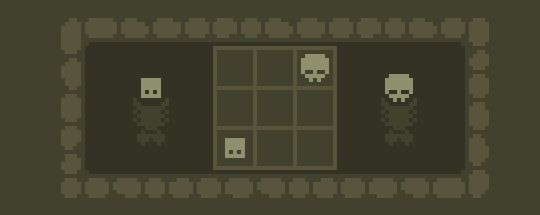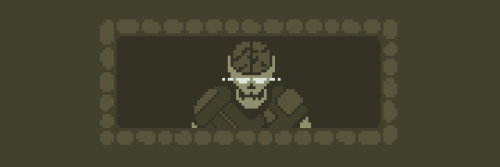I played the demo to Seek Etyliv in a tiny window floating at the centre of my screen. All play takes place in 3×3 grid. The game features precisely six colours. Player input is limited to arrow key controlled movement, one square at a time, with spacebar to focus on enemies’ inventories. There is no music and only sparse, functional sound effects.
Seek Etyliv is utterly captivating.
There is no dialogue here; only short, introspective textual reflections between levels. The dimensions of each dungeon are clear; the specifics are only hinted at.

Pixelated facsimiles of chests, weapons and undead foe make no indulgences beyond the strictly representational. No Elysian trumpets will announce victory, defeat, entrances, exits.
Seek Etyliv is evocative.
Lonely. Mournful. Hopeful.
I had learnt most of the mechanics, rules, and interactions in Seek Etyliv in the space of a short tutorial. With no hints, text boxes or further tutorials, any additional complexities were grasped within seconds of them being introduced.
Seek Etyliv is compulsive.
Refined. Elegant in its intuitive complexity.

The title is an anagram of word in Lithuanian meaning pure love and life of eternal hope. Its creator, Rokas describes the game as a ‘Distilled Dungeon Crawler’. The full version will feature more weapons, enemies and levels. You can play the game here.
These are all facts. Dots. Lines. Grids. Shapes. They are not the experience of Seek Etyliv, just surrounding ephemera. It knows that flesh and blood are bells and whistles – the skeleton; key. Every aspect has been parred down to only its most necessary functions, and the result is outstandingly cohesive purity of design. It dissects similar experiences, deciding that their vital organs are not as vital as they may first appear. Seek Etyliv is a skeleton crew doing the work of legion, an exquisite corpse.



